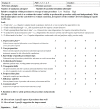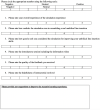The Development of a Simulated Umbilical Line Insertion Model and Curriculum in the Neonatal Intensive Care Unit
- PMID: 33763314
- PMCID: PMC7980722
- DOI: 10.7759/cureus.13418
The Development of a Simulated Umbilical Line Insertion Model and Curriculum in the Neonatal Intensive Care Unit
Abstract
Background Insertion of an umbilical venous catheter (UVC) is a required skill for pediatric residents to learn and perform effectively. However, there is known variability in the ability of residents to perform this essential neonatal skill. Objective The objective of our study was to create a competency-based curriculum for umbilical vein catheter insertion using a human umbilical tissue simulated model, and to assess the feasibility of the curriculum on resident learners during their neonatology rotations. Methods We evaluated the curriculum by assessment of resident learning, reactions, and behaviours. Performance was assessed using the Ottawa Surgical Competency Operating Room Evaluation (O-SCORE). Results A total of 14 residents were included for analysis. The majority were 'senior' residents (postgraduate year (PGY)-3 and PGY-4 n = 10; PGY-1 n =4), and they reported a wide range of previous experience with UVC insertion prior to this curriculum implementation. The residents' reaction to the curriculum was overwhelmingly positive. All residents maintained or improved in their knowledge assessment. O-SCORE results showed improvement in UVC insertion before and after curriculum completion for both junior (2.5 +/- 0.71 to 4.5 +/- 0.41) and senior (3.55 +/- 0.42 to 4.95 +/- 0.15, p < 0.001) residents. The mean improvement in O-SCORE was greater for junior residents than senior residents. Conclusion The results of this study demonstrate the feasibility and emerging impact of a competency-based curriculum using simulation for procedural skills.
Keywords: competency-based assessment; neonatology; procedural skills; residency training; simulation; umbilical venous catheter.
Copyright © 2021, Gupta et al.
Conflict of interest statement
The authors have declared that no competing interests exist.
Figures




Similar articles
-
Boot cAMP: educational outcomes after 4 successive years of preparatory simulation-based training at onset of internship.J Surg Educ. 2012 Mar-Apr;69(2):242-8. doi: 10.1016/j.jsurg.2011.08.007. J Surg Educ. 2012. PMID: 22365874
-
A Competency-based Laparoscopic Cholecystectomy Curriculum Significantly Improves General Surgery Residents' Operative Performance and Decreases Skill Variability: Cohort Study.Ann Surg. 2022 Dec 1;276(6):e1083-e1088. doi: 10.1097/SLA.0000000000004853. Epub 2021 Mar 1. Ann Surg. 2022. PMID: 33914474
-
Simulation-based mastery learning reduces complications during central venous catheter insertion in a medical intensive care unit.Crit Care Med. 2009 Oct;37(10):2697-701. Crit Care Med. 2009. PMID: 19885989
-
An Analysis of Operative Experiences of Junior General Surgical Residents and Correlation With the SCORE Curriculum.J Surg Educ. 2016 Nov-Dec;73(6):e9-e13. doi: 10.1016/j.jsurg.2016.07.003. Epub 2016 Aug 8. J Surg Educ. 2016. PMID: 27515032 Review.
-
Resident Training and the Assessment of Orthopaedic Surgical Skills.JB JS Open Access. 2021 Dec 23;6(4):e20.00173. doi: 10.2106/JBJS.OA.20.00173. eCollection 2021 Oct-Dec. JB JS Open Access. 2021. PMID: 34964000 Free PMC article. Review.
References
-
- Intravascular catheter complications in the neonatal intensive care unit. Hermansen MC, Hermansen MG. Clin Perinatol. 2005;32:141–156. - PubMed
-
- Objectives of training in pediatrics. [Dec;2020 ];https://www.royalcollege.ca/rcsite/documents/ibd/pediatrics_otr_e.pdf 2020
-
- Assessing procedural skills training in pediatric residency programs. Gaies MG, Landrigan CP, Hafler JP, Sandora TJ. Pediatrics. 2007;120:715–722. - PubMed
LinkOut - more resources
Full Text Sources
Other Literature Sources
